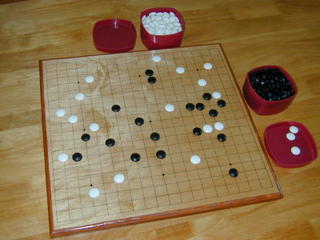Go
 Go is played on a 19 x 19 line board. One player takes black stones the other takes white. Players take turns placing their stones on the intersections of the 19 x 19 line board. The object is to control the most area on the board. Each intersection represents one point.
Go is played on a 19 x 19 line board. One player takes black stones the other takes white. Players take turns placing their stones on the intersections of the 19 x 19 line board. The object is to control the most area on the board. Each intersection represents one point.When placing a stone on a intersection, any adjoining intersection to that stone is called a liberty. Several stones of the same color that are adjoined together can form a group. A group can consist of one or more stones. The intersection that are surrounded by your group is your territory. A group can stay alive as long as it has one free liberty. If a group has all it's liberties taken by your opponents stones the group is captured, and removed from the board.
When a stone is captured in such a way that your opponent can recapture by playing the exact same intersection represents a "Ko". This is the only illegal move that has some restrictions when playing Go. A "Ko", which means eternity, if not checked, can abrupt the game and make it un-playable, by infinitely trading stones. If this situation comes up the player that starts the "Ko" fight must be given the opportunity to plug the "Ko" intersection, which means that the opponent must play elsewhere on the board on the following turn. More often than not your opponent will find a place to threaten another postion on the board, there by creating a "Ko threat", if the "Ko threat" is answered then the opponent can re-initiate the "Ko" fight again.
In Japanese counting rules, intersections and prisoners equal the total amount of points. In Chinese counting rules, intersections and the number of stones still in play on the board equal the total number of points. Whether you use the Chinese or the Japanese rules the results of the game are usually the same winner.

0 Comments:
Post a Comment
<< Home